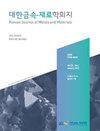Effect of Mg Content and Cooling Rate After Solidification on the Mechanical Properties of T5-treated Al-Si-Mg Alloy
IF 1.1
4区 材料科学
Q4 MATERIALS SCIENCE, MULTIDISCIPLINARY
引用次数: 0
Abstract
The effects of Mg content and cooling rate on the T5 treatment of Al-Si-Mg alloys have been investigated using Avrami kinetics and transmission electron microscopy. The alloys were super-heated at 800 oC for 1 hr followed by degassing treatment at 720 oC for 15 min, and poured into a metallic mold preheated to 250 oC. The as-cast alloys were then T5-treated at a temperature of 190 oC. As the Mg content and/or cooling rate increased, the strength of the T5-treated alloys increased while the elongation decreased over the entire aging time. However, some T5 treatment conditions were effective to at enhancinge elongation as well as strength. The alloy with low Mg content showed excellent elongation in the early stage of aging. B, but as the aging time increased, h. However, the elongation decreased rapidly so that there was showed no significant difference from with the alloy with high Mg content in the over-aging stage. This was due to a coarse and agglomerated precipitate structure, which were likely to be formed by the rapid precipitation and agglomeration of the β′ phase. The alloy with a high cooling rate exhibited superior strength with similar elongation over the entire aging time compared to the slowly cooled alloy. The reason for the decrease in strength for in the slowly cooled alloy was attributed to the coarsening of precipitates and suppression of the formation of fine precipitates during cooling.Mg含量和凝固后冷却速度对t5处理Al-Si-Mg合金力学性能的影响
用Avrami动力学和透射电子显微镜研究了Mg含量和冷却速率对Al-Si-Mg合金T5处理的影响。将合金在800℃下过热1小时,然后在720℃下脱气处理15分钟,并倒入预热至250℃的金属模具中。然后在190℃的温度下对铸态合金进行T5处理。随着Mg含量和/或冷却速率的增加,T5处理合金的强度增加,而伸长率在整个时效时间内降低。然而,一些T5处理条件对提高伸长率和强度是有效的。镁含量低的合金在时效早期表现出优异的伸长率。B、 但随着时效时间的增加,h。然而,伸长率迅速下降,因此在过时效阶段与高Mg含量的合金没有显著差异。这是由于β′相的快速沉淀和团聚可能形成了粗糙和团聚的沉淀结构。与缓慢冷却的合金相比,具有高冷却速率的合金在整个时效时间内表现出优异的强度和相似的伸长率。在缓慢冷却的合金中,强度降低的原因归因于沉淀物的粗化和冷却过程中细沉淀物的形成被抑制。
本文章由计算机程序翻译,如有差异,请以英文原文为准。
求助全文
约1分钟内获得全文
求助全文
来源期刊

Korean Journal of Metals and Materials
MATERIALS SCIENCE, MULTIDISCIPLINARY-METALLURGY & METALLURGICAL ENGINEERING
CiteScore
1.80
自引率
58.30%
发文量
100
审稿时长
4-8 weeks
期刊介绍:
The Korean Journal of Metals and Materials is a representative Korean-language journal of the Korean Institute of Metals and Materials (KIM); it publishes domestic and foreign academic papers related to metals and materials, in abroad range of fields from metals and materials to nano-materials, biomaterials, functional materials, energy materials, and new materials, and its official ISO designation is Korean J. Met. Mater.
 求助内容:
求助内容: 应助结果提醒方式:
应助结果提醒方式:


